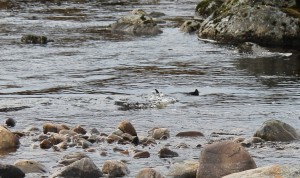The Conservation Volunteers and Fishery Board staff are on track to finish clearing Rhododendron from the banks of the River Orrin this winter. In some areas chainsaws are being used by wherever possible a technique called ‘lever and mulch’ is being used. This method uses hand tools to cut branches back and then leverage is applied to the main stems to either break them at ground level or uproot them completely. The cut branches then act as a mulch to prevent regrowth. This method can be very effective and requires less follow up treatment than traditional cutting and burning.
Before clearance works
After clearance works. Not only are stems removed but also roots and stumps. The lack of vegetation under the rhododendron shows how damaging it is to riverbank habitats, increasing erosion and supressing native plants.
Later in the spring with the support of the Woodland Trust native trees will be planted into some of the areas previously cleared on the Orrin.










